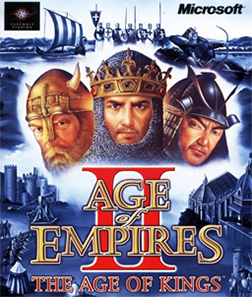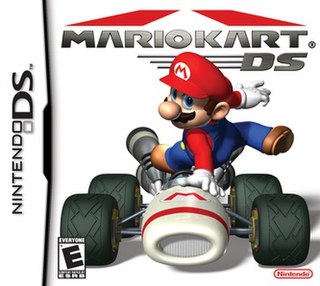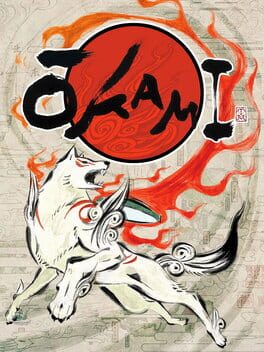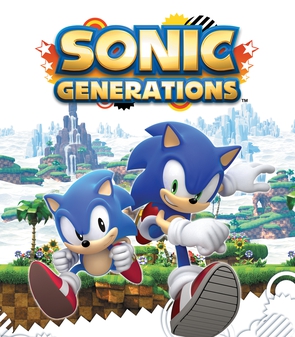
Age of Empires II: The Age of Kings is a real-time strategy video game developed by Ensemble Studios and published by Microsoft. Released in 1999 for Microsoft Windows and Macintosh in 2001, it is the second game in the Age of Empires series. The Age of Kings is set in the Middle Ages and contains thirteen playable civilizations. Players aim to gather resources, which they use to build towns, create armies, and defeat their enemies. There are five historically based campaigns, which conscript the player to specialized and story-backed conditions, as well as three additional single-player game modes; multiplayer is also supported.
Wipeout is a series of futuristic anti-gravity racing video games developed by Studio Liverpool.

Mario Kart DS is a 2005 kart racing video game developed by Nintendo EAD Group No. 1 and published by Nintendo for the Nintendo DS handheld game console. It was released in November 2005 in North America, Europe, and Australia, and on December 8, 2005, in Japan. The game was re-released for the Wii U's Virtual Console in North America and PAL regions in April 2015 and in Japan in May 2016.

Hitman: Blood Money is a 2006 stealth video game developed by IO Interactive and published by Eidos Interactive. It was released in May 2006 for Microsoft Windows, PlayStation 2, Xbox and Xbox 360. It is the fourth installment in the Hitman video game series, and the sequel to 2004's Hitman: Contracts. The story follows cloned assassin Agent 47's efforts to bring down the Franchise, a rival contract killing organization that is threatening his employers, the International Contract Agency (ICA), and seeking to obtain the same cloning technology that created 47. Meanwhile, a frame story presents 47's life and various contracts he carried out, as narrated by a former FBI director to a journalist.

Lumines: Puzzle Fusion is a 2004 puzzle game developed by Q Entertainment and published for the PlayStation Portable by Bandai in Japan and by Ubisoft elsewhere. The objective of the game is to arrange descending two-colored 2×2 blocks to create 2×2 squares of matching color. A vertical line known as the "time line" sweeps across the field, erases completed squares, and awards points. Each stage has a skin that affects the background, block colors, music, and the speed of the time line.

Meteos is a 2005 tile-matching video game developed by Q Entertainment and published by Bandai for the Nintendo DS. It was produced by Q Entertainment founder Tetsuya Mizuguchi and designed by Masahiro Sakurai. Meteos was inspired by the video game Missile Command (1980), the film The Matrix (1999) and the television series 24 (2001-2010).

Ōkami is an action-adventure video game developed by Clover Studio and published by Capcom. It was released for PlayStation 2 in 2006 in Japan and North America, and in 2007 in Europe and Australia. After the closure of Clover Studio a few months after the release, a port for Wii was developed by Ready at Dawn, Tose, and Capcom, and released in 2008.

Guitar Hero is a 2005 music rhythm video game developed by Harmonix and published by RedOctane for the PlayStation 2. It is the first main installment in the Guitar Hero series. Guitar Hero was released in November 2005 in North America, April 2006 in Europe and June 2006 in Australia. The game's development was a result of collaboration between RedOctane and Harmonix to bring a Guitar Freaks-like game to United States.

Zune is a discontinued brand of digital media products and services that was marketed by Microsoft from November 2006 until June 2012. Zune consisted of a line of portable media players, a music subscription service known as Zune Music Pass plus Zune Marketplace for music, TV and movies, streaming services for the Xbox 360 game console, and the Zune software media player for Windows PCs which also acted as desktop sync software for Windows Phone.

Super Street Fighter II Turbo HD Remix is a two dimensional fighting game released using the PlayStation Store and Xbox Live Arcade download services. A physical copy of the game was later released as part of Capcom Digital Collection. It is a remake of Super Street Fighter II Turbo featuring the original game and a high definition version using graphics drawn by UDON Entertainment, and arranged music by OverClocked ReMix members. The game was designed by Backbone Entertainment's David Sirlin to be the sixth definitive version of Street Fighter II, although it is in fact the seventh, being released after Hyper Street Fighter II.

The Orange Box is a video game compilation containing five games developed and published by Valve. Two of the games included, Half-Life 2 and its first stand-alone expansion, Episode One, had previously been released as separate products. Three new games were also included in the compilation: the second stand-alone expansion, Half-Life 2: Episode Two, the puzzle game Portal, and Team Fortress 2, the multiplayer game sequel to Team Fortress Classic. Valve also released a soundtrack containing music from the games within the compilation. A separate product entitled The Black Box was planned, which would have included only the new games, but was later canceled.

Mario Kart Wii is a 2008 kart racing game developed and published by Nintendo for the Wii. It is the sixth installment in the Mario Kart series, and was released in April 2008. Like its previous installments, Mario Kart Wii incorporates playable characters from the Mario series, who participate in races on 32 different race tracks using specialized items to hinder opponents or gain advantages. The game features multiple single-player and multiplayer game modes including two to four person split screen. Online multiplayer was supported until the discontinuation of Nintendo Wi-Fi Connection in May 2014. Mario Kart Wii uses the Wii Remote's motion-controls to provide intuitive and conventional steering controls. Each copy of the game was bundled with the Wii Wheel accessory to augment this feature and mimic a steering wheel.

World of Goo is a physics-based puzzle video game developed and published by independent game developer 2D Boy. The game was released on Microsoft Windows and Wii on October 13, 2008, with releases on Nintendo Switch, Mac OS X, Linux, and various mobile devices in subsequent years. World of Goo has the player use small balls of goo to create bridges and similar structures over chasms and obstacles to help other goo balls reach a goal point, with the challenge to use as few goo balls as possible to build this structure.

Bit.Trip, stylized BIT.TRIP, is a series of eight video games developed by Choice Provisions and published by Aksys Games for the Wii, Nintendo 3DS, Microsoft Windows, macOS, PS Vita, and PS4. It was published by Arc System Works for WiiWare and Nintendo eShop in Japan, and by Namco Networks America Inc for the iPhone, iPod Touch and iPad. Each game revolves around the adventures of a character named "Commander Video", and features "a crazy mix of 80s aesthetics and modern game design". The styles of the games range from pong-like, to platforming, and shooting. Each game in the series features a chiptune-inspired soundtrack, but a different style of rhythm-based gameplay in each. Most games in the series have few levels; Beat, Core, Void and Flux have only three levels each while Fate has six and Runner has 36. Most of the games feature levels lasting between 10 and 25 minutes to make up for having such few levels. The games also consists of 8 modes; Nether, Hyper, Mega, Super, Ultra, Extra, Giga, and Meta; which changes based on how well the player does. Each successive game adds a new mode, the highest being Mega in Beat, and Meta in Flux.

Bit.Trip Beat, marketed as BIT.TRIP BEAT, is an arcade-style music video game developed by Gaijin Games and published by Aksys Games for the Wii's WiiWare download service. It was released in 2009 in North America, and released in Japan and PAL regions in the same year. It was later released for the Windows and Mac OS X through the download service Steam in 2010, while Namco Bandai published it for iOS on iPod Touch, iPhone, and iPad in both Bit.Trip Beat and Bit.Trip Beat HD versions. Android and Linux versions debuted in the Humble Android Bundle 3.

The Zune HD is a portable media player in the Zune product family released on September 15, 2009, by Microsoft. It was a direct competitor with Apple's iPod Touch series of mobile devices. It was initially released in 16 and 32 GB capacities. A 64 GB version was released on April 9, 2010. It has a touchscreen interface for navigation and included Wi-Fi for synchronization, access to the Zune Marketplace and Web browsing.

Trials HD is an Xbox Live Arcade game developed by RedLynx and published by Microsoft Game Studios. It was released on August 12, 2009 as part of the second annual Xbox Live Summer of Arcade and was later re-released in a retail pack alongside Limbo and 'Splosion Man in April 2011. It is a 2.5D puzzle/racing game. The player must guide a trial motorcycle with exaggerated physics through various obstacles to reach each stage's finish line. On September 6, 2012 it was announced that a Microsoft Windows version of Trials HD would be bundled inside a special version of Trials Evolution, dubbed Trials Evolution: Gold Edition—although this version changes the physics of the game. It is the third game in the series. On February 11, 2016, Microsoft added Trials HD as part of its backwards compatibility program for Xbox One.

Sonic Generations is a 2011 platform game developed by Sonic Team and published by Sega for the PlayStation 3, Xbox 360, Windows, and Nintendo 3DS. Produced in commemoration of the 20th anniversary of the Sonic the Hedgehog series, the game follows Sonic and his sidekick Tails as they form an alliance with their modern selves. It features two gameplay styles: "Classic", which plays from a side-scrolling perspective like that of the original Sega Genesis Sonic games, and "Modern", 3D levels similar to those in Sonic Unleashed (2008) and Sonic Colors (2010).

Guacamelee! is a Metroidvania action platforming video game developed and published by DrinkBox Studios, initially launched in April 2013 for platforms PlayStation 3 and PlayStation Vita and was later ported to Windows in August and to OS X and Linux in February 2014. The enhanced Super Turbo Championship Edition was released for Wii U, Windows, PlayStation 4, Xbox One, and Xbox 360 in July 2014 and later on the Nintendo Switch in October 2018. The game is inspired by traditional Mexican culture and folklore, like alebrijes and Day of the Dead.

Audiosurf 2, previously named Audiosurf Air, is a rhythm game created by Dylan Fitterer, and the sequel to Audiosurf. It was launched on October 2, 2013, for Windows through Steam Early Access, OS X and Linux versions were released on January 9, 2015. The game is Steam Workshop compatible, allowing players to create and share mods for the game. It came out of early access on May 26, 2015.






















